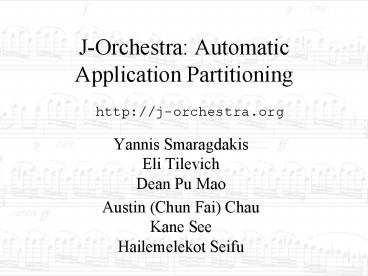JOrchestra: Automatic Application Partitioning - PowerPoint PPT Presentation
1 / 26
Title:
JOrchestra: Automatic Application Partitioning
Description:
Proxies hide the location of the actual object: objects can move at ... System classes are accessed through special proxies, but access each other directly ... – PowerPoint PPT presentation
Number of Views:130
Avg rating:3.0/5.0
Title: JOrchestra: Automatic Application Partitioning
1
J-Orchestra Automatic Application Partitioning
http//j-orchestra.org
- Yannis SmaragdakisEli TilevichDean Pu Mao
- Austin (Chun Fai) ChauKane SeeHailemelekot Seifu
2
Automatic Application Partitioning?
- Application Partitioning breaking up an
application into pieces that run on different
network locations - e.g., sensor inputs are controlled by one
machine, data processing is done on another,
storage is handled by a third - Automatic Application Partitioning instead of
rewriting an application by hand, have a tool
handle all the details under human guidance
3
J-Orchestra
- Given any centralized Java program (in bytecode
format) partition it - make distribution decisions about the program
components - possibly with some user input
- taking into account the results of static
analysis - automatically rewrite the program so that it runs
with some middleware mechanism (e.g., Java RMI,
CORBA, etc.) - only the program changes, not the VM/system code
4
Example
DB
Program as a sea of classes
sensor
UI
5
Benefits and Competition
- The benefit is very significant no need to
partition programs by hand - application partitioning is a major need in the
internet era - imagine an alternative to applets, servlets,
X-Windows, telnet, more - think of the embedded systems applications
- J-Orchestra is by far the most powerful
auto-partitioning system - others exist but have severe limitations in how
they can partition applications
6
3 Main Elements of Approach
- Powerful back-end
- can partition along any application and many
system class boundaries - Profiling
- estimate data coupling during a run of the
program - Static analysis
- used for separating system classes, optimization
7
J-Orchestra back-end What makes it special!
http//j-orchestra.org
8
Where is the magic?
- It may seem like the issue is just a small matter
of programming - just change all method calls and direct field
access to RMI calls, do bytecode rewriting to
make all objects remotely invokable - For every complex problem there is a solution
that is simple, elegant, and wrong - doesnt work because of aliasing! Objects on
different locations may be sharing data through
references
9
Call-by-copy
- RMI semantics call-by-copy
- the entire state of the system reachable from a
parameter is passed by value - arguments are serialized recursively and copied
over the network - copies are not kept consistent, changes do not
propagate back
10
Example remote call foo(p)
p
p
alias2
alias1
11
Example remote call foo(p)
changes never make it back!
p
p
alias2
alias1
12
What if...
- We can keep the objects only on their creation
site and make them remotely accessible (using
bytecode rewriting)
p
p
alias2
alias1
- Very inefficient (no mobility) and limited (w.r.t
native code)
13
Solution
- We can change all references from direct to
indirect (through proxies)
p
alias2
alias1
14
Solution
- We can change all references from direct to
indirect (through proxies)
p
alias2
alias1
15
Solution
- Proxies hide the location of the actual object
objects can move at will to exploit locality
Site 1
Site 2
p
alias2
alias1
16
Details
- Proxies
- retain the method interface of the original class
- delegate all calls to potentially remote sites
- Remote objects
- binary modified original classes to understand
RMI - serializable, no direct access to members
17
The fun has just begun
- What about system classes?
- other system classes (e.g., native code) rely on
accessing them directly - e.g., native code is compiled to a particular
object layout, like accessing a field at a
certain offset from the object location - system classes need to be accessed remotely, but
they are unmodifiable - because other system classes access them directly
18
Solution
- System classes are accessed through special
proxies, but access each other directly
Site 1
Site 2
p
alias2
alias1
19
- What if a system object is passed from system
code to user code and vice-versa? - here is an example with both cases q has to
become q or the code of class R wont work - System proxies are responsible for both
translations (wrapping/unwrapping)
r.foo(q)
q
r
q
R
20
Profiling for Performance
http//j-orchestra.org
21
Profiling
- We interpose our profiling code in the Java VM
method calling mechanism - every time a method is called, we determine the
amount of state reachable from the arguments - this determines the data coupling between two
classes - Profiling is a good way to discover application
behavior without an intrusive runtime
22
Static Analysis
http//j-orchestra.org
23
Static Analysis
- We analyze the application at several levels
- basic analysis (call-graph, inheritance
hierarchy) - what system classes are used (recursively)
- to see what we need to rewrite and how, where to
put them on a network (depending on which class
uses them) - what application classes are subclasses of system
classes - these will be treated as system classes
- advanced analysis future work (mostly)
- how does a method use its arguments
(aliased/modified)? What data need to be
serialized?
24
Concluding
http//j-orchestra.org
- (why do you call it J-Orchestra?)
25
Related Work
- Auto partitioning systems Addistant, Pangaea,
Coign - very limited
- Distributed programming infrastructure
JavaParty, Doorastha - not automatic
- DSM systems
- but these change the runtime
26
Summary
- J-Orchestra is the first fully general
auto-partitioning system - large, complex bytecode rewriting infrastructure,
several conceptual problems solved for the first
time - Many other interesting aspects of the system are
performance related - dynamic profiling, static analysis































